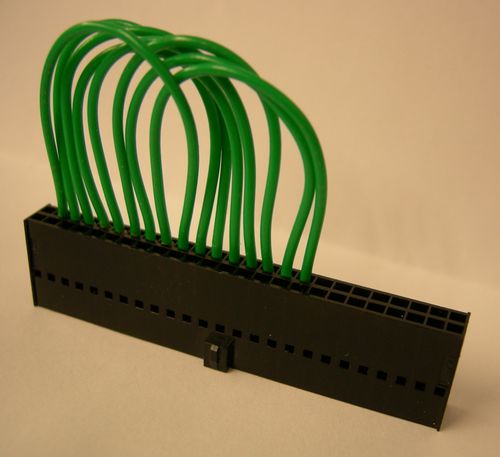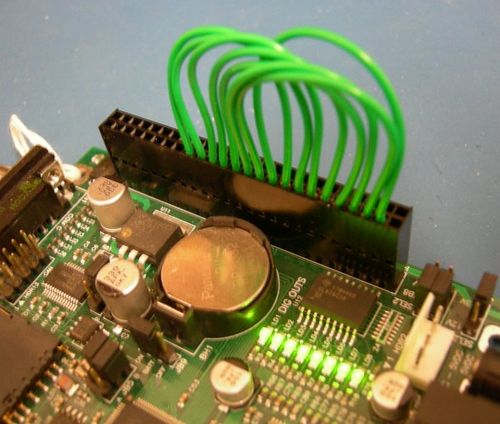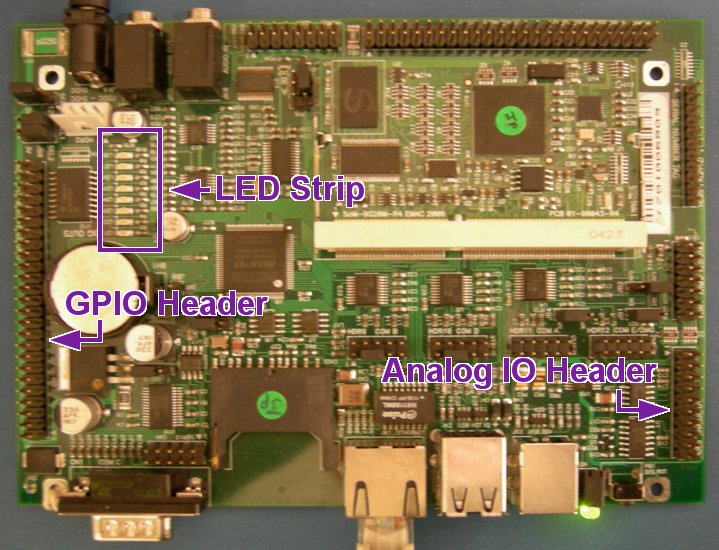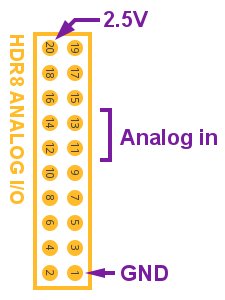Difference between revisions of "Example io demo"
m (Added OE5 instructions) |
|||
| (136 intermediate revisions by 5 users not shown) | |||
| Line 1: | Line 1: | ||
| − | {{todo| | + | {{todo|SEOKWREV (01.03.14-16:47->JG+);(01.03.14-17:35->MD+);(04.07.14-09:45->BS+);(04.09.14-16:15->BS+)|Jgreene|project=oe 4,oe 5,jg,md,SEOKWREV,ky,bs}} |
| − | |||
| − | + | {{#seo: | |
| − | + | |title=io demo | |
| − | This | + | |titlemode=append |
| − | + | |keywords=ADC example,Ring Counter,Binary Counter | |
| + | |description=This is a guide to the <code>io_demo</code> C example project included in the EMAC OE SDK. | ||
| + | }} | ||
| + | This is a guide to the <code>[http://git.emacinc.com/OE/qt-creator-example-projects/tree/master/io_demo io_demo]</code> C example project included in the EMAC OE SDK. | ||
| − | + | The <code>io_demo</code> project provides four examples using SOM-150ES carrier board I/O:<br /> | |
| + | * An analog-to-digital converter demo. | ||
| + | * A counter demo. | ||
| + | * An input-to-output demo. | ||
| + | * A ring demo. | ||
| + | The <code>io_demo</code> project builds one executable: <code>io_demo</code>. | ||
| + | == Opening, Building and Uploading the Project Files == | ||
| + | |||
| + | For information on opening the project from within Eclipse, please see [[Importing the EMAC OE SDK Projects with Eclipse]]. Then, follow [[Using the EMAC OE SDK Projects with Eclipse]] for information on how to build, upload and execute the example. | ||
| + | |||
| + | Alternatively, the <code>Makefile</code> can be used with the <code>make</code> command from the commandline to build and upload the example. For more information on this method, please see [[Using EMAC OE SDK Example Projects]]. | ||
| − | == | + | For use in EMAC SDK 5.X, please refer to the updated version of this example project: [[Libgpiod_IO_Example|libgpiod_io]] |
| + | |||
| + | == Usage and Behavior == | ||
| + | |||
| + | ===Hardware Requirements=== | ||
| + | |||
| + | To use the '''io demo''' program you will need the following hardware. | ||
| + | |||
| + | * An EMAC [http://www.emacinc.com/som/som150es.htm SOM-150ES] carrier board. <br /> | ||
| + | * A compatible EMAC SoM for that carrier board ([http://www.emacinc.com/products/system_on_module/SoM-9260M SOM-9260M], [http://www.emacinc.com/products/system_on_module/som-9G20m SOM-9G20M] and [http://www.emacinc.com/products/system_on_module/som-9x25 SOM-9X25] are all compatible).<br /> | ||
| + | * A multimeter or oscilloscope. See [[Example_io_demo#Input_to_Output_Demo_Usage | Input to Output Demo]] and [[Example_io_demo#Count_Demo_Usage | Count Demo]] for details.<br /> | ||
| + | * A cable long enough to reach from GPIO Port B to GPIO Port C. See [[Example_io_demo#Input_to_Output_Demo_Usage | Input to Output Demo]] for details.<br /> | ||
| + | |||
| + | ====Carrier Board==== | ||
| + | |||
| + | [[File:know_your_som_150.jpg|frame|left|SOM-150ES carrier board with GPIO, LEDs and analog IO indicated.]] | ||
| + | <br clear=all> | ||
| + | |||
| + | This is a detail of the '''HDR1 PLD & BUFFERED GPIO''' header. Pin 49 is Vcc. The bottom pins: 2, 4, 6...46, 48, 50; are all ground. Port A is pins 1, 3, 5, 7, 9, 11, 13, 15. Port B is pins 17, 19, 21, 23, 25, 27, 29, 31. Port C is pins 33, 35, 37, 39, 41, 43, 45, 47. | ||
| + | |||
| + | [[File:gpio_header_detail.png]] | ||
| + | |||
| + | ===io_demo Usage=== | ||
| − | + | Run '''io demo''' from the console. It takes no parameters. | |
| − | + | <syntaxhighlight lang="text"> | |
| + | ./io_demo | ||
| + | </syntaxhighlight> | ||
| − | < | + | This brings up a menu of demos.<br /> |
| + | <syntaxhighlight lang="console"> | ||
| + | **************************** | ||
| + | Demo Menu | ||
| + | |||
| + | A/D Demo - a | ||
| + | Count Demo - c | ||
| + | Input to Output Demo - i | ||
| + | Ring Demo - r | ||
| + | |||
| + | Exit - x | ||
| + | |||
| + | Enter Selection: | ||
| + | </syntaxhighlight> | ||
| − | + | Now, press '''a''', '''c''', '''i''' or '''r''' to run a demo; otherwise, press '''x''' to exit. | |
| − | + | ===A/D Demo Usage=== | |
| − | + | From the demo menu press '''a'''. | |
| − | < | + | <syntaxhighlight lang="text"> |
| + | **************************** | ||
| + | Demo Menu | ||
| + | |||
| + | A/D Demo - a | ||
| + | Count Demo - c | ||
| + | Input to Output Demo - i | ||
| + | Ring Demo - r | ||
| + | |||
| + | Exit - x | ||
| + | |||
| + | Enter Selection: a | ||
| − | + | A/D Demo | |
| + | [0]=126 [1]=11B [2]=12C [3]=12B | ||
| + | </syntaxhighlight> | ||
| − | + | The output shows the stray charge on the inputs being read by the analog-to-digital converter on pins 11, 12, 13, 14. Press '''a''' a few times to watch the values change. | |
| − | This is | + | This is the HDR8 ANALOG IO header. |
| − | [[File: | + | [[File:analog_io_header_detail.jpg]] |
| − | |||
| − | ' | + | Let's do a couple of experiments on our analog in pins. |
| − | + | Connect pin 20 to pin 11 and hit '''a'''. Note that the first value is higher than the others. It should read approximately '''3FF'''. This means that the first analog-in pin has 2.5V on it. | |
| − | + | Connect pin 1 to pin 11. Hit '''a'''. Note that the first value is lower than the others. It's the vicinity of 0. That means that the first analog-in pin is pulled down to ground. | |
| − | |||
| − | |||
| − | === | + | ===Count Demo Usage=== |
| − | + | From the demo menu press '''c'''. | |
| − | + | The system counts from 0 to 255 in binary. It takes about 15 seconds to complete.<br /> | |
| + | The steps of this process are reflected in the GPIO PortC header pins (see [[Example_io_demo#Carrier_Board | Carrier Board]], above). As each bit in our 8-bit register is set to 1, the corresponding pin in the PortC header momentarily registers 5 volts (easily detected with a multimeter or oscilloscope). | ||
| − | + | More visibly, the counting process is also reflected in the strip of 8 LEDs on the board LD1-LD8. (see [[Example_io_demo#Carrier_Board | Carrier Board]], above). A lit LED indicates a 1 in our 8-bit register and an unlit LED indicates a 0. When the counting process is finished, all 8 LEDs are lit (255). | |
| − | + | ===Input to Output Demo Usage=== | |
| − | + | In this usage example the carrier board talks to itself. We send an 8-bit data stream directly from Port B to Port C via a short piece of cable. See [[Example_io_demo#Carrier_Board | Carrier Board]], above, for details. | |
| − | + | This is the ribbon cable for the input-to-output demo. Note that we connect PortC:pin0 to PortB:pin0; PortC:pin1 to PortB:pin1; etc.<br /> | |
| + | [[File:iodemo_homemaderibboncable.jpg|500px|border|]] | ||
| − | + | Here's the cable plugged into the GPIO header. You see that PortC:pin0 outputs to PortB:pin0; PortC:pin1 outputs to PortB:pin1; etc. | |
| + | [[File:iodemo_homemaderibboncable_closeup.jpg|500px|border|]] | ||
| − | + | The data stream for each pin is 1, 0, 1, 0, 1, 0... That is to say: all pins are set to 1, then they are all set to 0, then to 1 again, etc. We observe our data stream in the strip of 8 LEDs on the carrier board. They blink in unison. | |
| − | The | + | '''Note''' The blinking may get a little out of sync after a few seconds. This is normal. |
| − | ===Ring Demo=== | + | ===Usage Example. Ring Demo=== |
| − | + | From the demo menu press '''r'''. | |
| − | [[ | + | The system sets a bit on Port C to 1, then sets it to 0, then sets the bit after that to 1, then sets that pin to 0, and so on, sequentially. This shows a ring counter on the LED strip (see [[Example_io_demo#Carrier_Board | Carrier Board]], above). |
| − | The | + | The steps of this process are reflected in the GPIO PortC header pins. As each bit in the 8-bit register is set to 1, the corresponding pin in the PortC header momentarily registers 5 volts (easily detected with a multimeter or oscilloscope). |
Latest revision as of 13:35, 25 September 2020
This is a guide to the io_demo C example project included in the EMAC OE SDK.
The io_demo project provides four examples using SOM-150ES carrier board I/O:
- An analog-to-digital converter demo.
- A counter demo.
- An input-to-output demo.
- A ring demo.
The io_demo project builds one executable: io_demo.
Contents
Opening, Building and Uploading the Project Files
For information on opening the project from within Eclipse, please see Importing the EMAC OE SDK Projects with Eclipse. Then, follow Using the EMAC OE SDK Projects with Eclipse for information on how to build, upload and execute the example.
Alternatively, the Makefile can be used with the make command from the commandline to build and upload the example. For more information on this method, please see Using EMAC OE SDK Example Projects.
For use in EMAC SDK 5.X, please refer to the updated version of this example project: libgpiod_io
Usage and Behavior
Hardware Requirements
To use the io demo program you will need the following hardware.
- An EMAC SOM-150ES carrier board.
- A compatible EMAC SoM for that carrier board (SOM-9260M, SOM-9G20M and SOM-9X25 are all compatible).
- A multimeter or oscilloscope. See Input to Output Demo and Count Demo for details.
- A cable long enough to reach from GPIO Port B to GPIO Port C. See Input to Output Demo for details.
Carrier Board
This is a detail of the HDR1 PLD & BUFFERED GPIO header. Pin 49 is Vcc. The bottom pins: 2, 4, 6...46, 48, 50; are all ground. Port A is pins 1, 3, 5, 7, 9, 11, 13, 15. Port B is pins 17, 19, 21, 23, 25, 27, 29, 31. Port C is pins 33, 35, 37, 39, 41, 43, 45, 47.
io_demo Usage
Run io demo from the console. It takes no parameters.
./io_demo
This brings up a menu of demos.
****************************
Demo Menu
A/D Demo - a
Count Demo - c
Input to Output Demo - i
Ring Demo - r
Exit - x
Enter Selection:
Now, press a, c, i or r to run a demo; otherwise, press x to exit.
A/D Demo Usage
From the demo menu press a.
****************************
Demo Menu
A/D Demo - a
Count Demo - c
Input to Output Demo - i
Ring Demo - r
Exit - x
Enter Selection: a
A/D Demo
[0]=126 [1]=11B [2]=12C [3]=12B
The output shows the stray charge on the inputs being read by the analog-to-digital converter on pins 11, 12, 13, 14. Press a a few times to watch the values change.
This is the HDR8 ANALOG IO header.
Let's do a couple of experiments on our analog in pins.
Connect pin 20 to pin 11 and hit a. Note that the first value is higher than the others. It should read approximately 3FF. This means that the first analog-in pin has 2.5V on it.
Connect pin 1 to pin 11. Hit a. Note that the first value is lower than the others. It's the vicinity of 0. That means that the first analog-in pin is pulled down to ground.
Count Demo Usage
From the demo menu press c.
The system counts from 0 to 255 in binary. It takes about 15 seconds to complete.
The steps of this process are reflected in the GPIO PortC header pins (see Carrier Board, above). As each bit in our 8-bit register is set to 1, the corresponding pin in the PortC header momentarily registers 5 volts (easily detected with a multimeter or oscilloscope).
More visibly, the counting process is also reflected in the strip of 8 LEDs on the board LD1-LD8. (see Carrier Board, above). A lit LED indicates a 1 in our 8-bit register and an unlit LED indicates a 0. When the counting process is finished, all 8 LEDs are lit (255).
Input to Output Demo Usage
In this usage example the carrier board talks to itself. We send an 8-bit data stream directly from Port B to Port C via a short piece of cable. See Carrier Board, above, for details.
This is the ribbon cable for the input-to-output demo. Note that we connect PortC:pin0 to PortB:pin0; PortC:pin1 to PortB:pin1; etc.

Here's the cable plugged into the GPIO header. You see that PortC:pin0 outputs to PortB:pin0; PortC:pin1 outputs to PortB:pin1; etc.

The data stream for each pin is 1, 0, 1, 0, 1, 0... That is to say: all pins are set to 1, then they are all set to 0, then to 1 again, etc. We observe our data stream in the strip of 8 LEDs on the carrier board. They blink in unison.
Note The blinking may get a little out of sync after a few seconds. This is normal.
Usage Example. Ring Demo
From the demo menu press r.
The system sets a bit on Port C to 1, then sets it to 0, then sets the bit after that to 1, then sets that pin to 0, and so on, sequentially. This shows a ring counter on the LED strip (see Carrier Board, above).
The steps of this process are reflected in the GPIO PortC header pins. As each bit in the 8-bit register is set to 1, the corresponding pin in the PortC header momentarily registers 5 volts (easily detected with a multimeter or oscilloscope).


